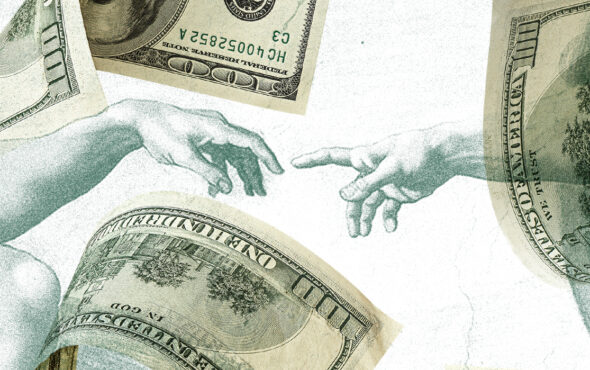
In 2022, on the set of one of the many made-for-TV romance movies that are shot every year, the crew was producing a scene where the supporting cast – a lesbian couple – have their first dance at the wedding of their dreams. As the music swells, the couple shares a chaste kiss and their families erupt in applause.
In the few holiday movies that feature queer characters, producers often avoid including moments that display same-sex intimacy. “These networks typically like to dip their toe in the pond,” a director of holiday romance films told Uncloseted Media. “They want to check off a box in terms of including a queer storyline, but they don’t want to go so far as to see characters kiss because that typically does not sell as well to the more Christian-based networks,” he says, noting that production companies shoot the movies first and then pitch them to various networks.
This director, who asked to remain on background to avoid jeopardising future opportunities, had advocated to include the lesbian peck and felt it was wrong to omit it. “It didn’t make sense from a filmmaking standpoint, from a directorial standpoint, and it didn’t make sense from a narrative standpoint. I made the argument that it’s a bit strange to see a couple go through their first dance and then at the end they just pull away from each other. And so I convinced them to let me shoot the kiss.”
But after they shot the scene, “the movie was packaged [without the peck] in order to sell it to as many domestic and international streaming services and networks as possible.” The film was eventually sold to multiple vendors.
The omission of any display of LGBTQIA+ intimacy is far from surprising in the over $500 million holiday movie industry. While in recent years, there has been some queer representation on networks like The Hallmark Channel, made-for-TV holiday movies still overwhelmingly depict heterosexual romance.
But even with these progressive steps, The Great American Family Channel (GAF) – a new major player in the holiday movie industry – is making bank by seemingly refusing to include any queer representation. Uncloseted Media was not able to find one openly LGBTQ character in any of their 71 holiday movies over the last four years.
This year, GAF signed a multi-year deal with actor Mario Lopez “with a focus to showcase diverse talent in front of the camera.” Despite this, in the 18 original Christmas films they released this season, there is once again not a single queer storyline that Uncloseted was able to identify.
“They’ve carved out some real estate which is defined by some very old school notions of family values. And it’s not being announced directly,” says Robert Thompson, Director of The Bleier Center for Television and Popular Culture at Syracuse University. Thompson says that the channel’s refusal to create inclusive stories is “a silent declaration of a certain brand.”
How it Began
The birth of GAF came shortly after a 2019 scandal at The Hallmark Channel, when the far-right group One Million Moms started a petition to keep Hallmark “family-friendly” after they aired a commercial featuring a lesbian couple. Hallmark decided to succumb to the pressure and discontinue the ad; a decision that was met with outrage from LGBTQIA+ viewers.
After this, Hallmark reversed its decision, put the ad back up and pledged to better represent the LGBTQIA+ community. One month later, Hallmark’s CEO Bill Abbott stepped down.
After his departure, Hallmark started including more LGBTQIA+ storylines in their holiday films, upsetting fans and spurring a wave of online backlash.
As this outrage became widespread, Abbott co-founded Great American Media, the parent company of GAF. Over the next year, he would be joined by a swath of former Hallmark executives and actors.
Abbott took what was a country music channel and rebranded it into a faith-based, family-friendly lifestyle channel. As part of this rebrand, Abbott decided to create original made-for-TV holiday films that, unlike Hallmark, would focus on a more traditional view of the holidays.
“There will always be a segment of the population that just wants to be able to not have to fast forward through something or feel uncomfortable when they’re watching with their kids,” Abbott said in an interview this year.
Since GAF officially launched in September 2021, its holiday programming has focused on the traditional and religious roots of Christmas and the family. But their definition of these sacred institutions seems to exist in a queer and trans-free world. Abbott and GAF did not respond to Uncloseted Media’s request for comment.
Why Queer Representation Matters
While the effect of holiday films on societal progress might feel minimal, research has shown that queer representation on TV has the ability to move the needle on the public’s perception of LGBTQIA+ people. A 2020 GLAAD Media study found that “48% of respondents who had been exposed to LGBTQIA+ people in the media say they are more accepting of gay and lesbian people,” when compared to the respondents who had not recently seen any queer people on their screens.
“I live in an extremely progressive and diverse and colourful place,” says the director, who lives in Toronto, the most diverse city in the world. “But I think there are many, many places in the states that are not that way,” he says, noting that the majority of holiday movies are shot in Canada.
“I think that there are young men and women and trans folks who are terrified to speak about their own truth and it does nothing for those people if the living room that they inhabit is filled with that content.”
Where the Controversy Began
GAF captured attention and controversy in 2022 when Candace Cameron Bure, former Full House star, left Hallmark, and promised fans that their new programming would focus on “traditional marriage” instead of LGBTQIA+ stories.
Her comments received intense backlash from fans and the LGBTQIA+ community and caused former GAF actor Neal Bledsoe to leave the channel, writing in a statement that “the thought that my work could be used to deliberately discriminate against anyone horrifies and infuriates me.”
In response, CEO Abbott distanced GAF from Bure’s comments, stating that her views do not reflect the company’s and that GAF “[doesn’t] have an agenda either way. It’s not in the faith-and-family playbook to have agendas that are either pro or anti,” he said in an interview with Variety.
Still, total exclusion of LGBTQIA+ characters has meant big business for Abbott’s network. Many holiday movie fans were thrilled with this shift and turned to GAF to escape the queer representation on Hallmark and other similar channels. In the “Great American Family Fan Community” Facebook Group with over 150,000 members, fans voiced homophobia and expressed their gratitude for GAF’s exclusion of queer characters.
“Forcing Hallmark into the alphabet group lifestyle programming is criminal,” wrote one user. “Time to take a stand and preserve the sanctity of the natural family order in as many areas of life that we can,” the same user added. Another user wrote about their passion for GAF’s movies: “I love this channel and also I don’t want to look at 2 men or 2 women kissing. It’s just not God’s way.” Each post garnered over 600 likes and over 200 comments.
Uncloseted Media reached the users who posted in the community but did not receive a response.
In addition, members of the community have criticised GAF when they aired a RuPaul’s Drag Race ad and an LGBTQIA+ themed commercial about PrEP, an HIV prevention drug that has been integral to ending the epidemic. One user commented asking if GAF has removed “the very non-family friendly AIDS drug ad with 2 men kissing.” GAF responded on Instagram, saying “Unfortunately, we don’t have any control over local commercials, and we sincerely apologise.”
Family Values
While GAF’s audience is still fractional to Hallmark’s 737,000 primetime viewers, the Christian alternative still averages 173,000 viewers in the coveted slot and is the 41st most popular channel on TV.
“They have identified and carved out a core audience,” says Thompson.
“They know that if they watch [holiday films] here, they’re not going to have to confront all of the kinds of stories that they’re hearing elsewhere and that they’re clutching their pearls over,” Thompson told Uncloseted Media.
The so-called family values brand that GAF has been capitalising on is one that has been popular on TV for upwards of a century: the white picket fence, Leave it to Beaver, 2.5 children type.
“They were always nuclear families, a husband and wife, in their first marriage [with] a couple of kids… Because it was such a predominant presence it became the mythical idea of what a family was,” says Thompson. Great American Media markets itself heavily as a “family-friendly” organisation. In its company blurb, the word ‘family’ appears in nearly every single sentence, sometimes more than once.
Jason Wrench, a professor of communication and media at the State University of New York, says the move toward family values is indicative of a bigger goal: national Christianity. “They have this desire to go back to something that never actually existed,” he says. “They’ve created a fantasy of what the past was or even how this country was founded.”
GAF movie scripts are flooded with Biblical language and the channel airs Bible quotes before many ad breaks. By doing this and by excluding queer characters, GAF has earned media and marketing. In the past few years, Focus on the Family, a powerful anti-LGBTQIA+ lobbying group, has written in support of GAF in numerous articles. And earlier this year, Abbott spoke about GAF on a podcast by The Daily Signal, a conservative media organization founded by The Heritage Foundation, who wrote Project 2025.
Holiday Movies and American Politics
While holiday movies may ostensibly seem disconnected from politics, Wrench believes they’re linked. Since the legalisation of gay marriage in 2015, far-right organisations have been collaborating to promote a narrative that excludes same-sex couples. “They are moving the pieces on their chessboard,” Wrench told Uncloseted Media. “I think sometimes it’s hard for us because we’re seeing it in the moment and we don’t see how this has been strategic.”
In today’s political climate, the notion of returning to traditional families like the ones promoted on GAF has taken centre stage. Project 2025, the 920-page document that was written by 140 former Trump administration officials, suggests that policies that support LGBTQIA+ equity “should be repealed and replaced by policies that support the formation of stable, married, nuclear families.”
Media Fragmentation and Echo Chambers
The popularity of GAF may be attributed to the fragmentation of media in recent years. “It used to be that there were three television stations that had more actual control over what was shown to the public,” says Wrench.
The lack of TV options meant shows that aired on the three networks had serious impact. When All in the Family – which was watched by over 20 million people each week – decided to include the first-ever gay sitcom character in 1971, it had a seismic effect on America’s perception of gay people. And in 1997, when Ellen DeGeneres came out on her self-titled sitcom, it was watched by more than 42 million people and was the highest-rated episode of the show.
“Television and popular culture was very good at licking the envelope shut on progressive issues because once it happened on a television show in the network era, it wasn’t an argument anymore,” says Thompson.
But today, people can look elsewhere when a channel’s programming doesn’t match their beliefs.
“[There are] an infinity of places where people can go to find the claims of affirmations that they need,” says Thompson.
In this new media ecosystem, polarisation has become profitable and media corporations have taken notice. It’s not only the holiday film industry that is capitalising off of existing in an echo chamber. The news, pop culture, science and podcasts are often fragmented along partisan lines. “Now, if you have a large enough population that doesn’t want to expose themselves to anything queer oriented, if a company sees that as a business model to make more money, they’re going to do that,” says Wrench.
The director of the film with the lesbian peck that never made it to your screen says GAF’s echo chamber only widens the gap between people’s varying beliefs about LGBTQIA+ issues. “It doesn’t help parents develop any sort of understanding and it doesn’t challenge their perspective on diversity and on queerness,” he says, noting that less than 40% of LGBTQIA+ youth consider their homes affirming.
Queer Exclusion Becomes Big Business
But he says that the market of traditional values is too big for GAF to pass up on. “It really does all come down to the money,” he says.
“The audience for these films is a middle-aged Christian woman who just wants to pour herself a glass of Chardonnay and forget about all the pain in the world.”
The exclusion of queer characters from GAF movies is occurring in parallel with a recent shift of US corporations abandoning Diversity, Equity, and Inclusion and LGBTQ initiatives under pressure from right-wing outrage. For months, big-name corporations like Harley-Davidson, Bud Light and Walmart have folded under pressure from conservative influencers who have started campaigns calling for divestment from inclusive practices.
And even this month, Disney removed a trans storyline from an animated streaming series prior to its release, with a spokesperson for the company telling The Hollywood Reporter that “when it comes to animated content for a younger audience, we recognise that many parents would prefer to discuss certain subjects with their children on their own terms and timeline.”
“There are definitely companies that have caught the rainbow and gone with it because it was socially appropriate,” says Wrench. “Those companies will become more hesitant as the pressure from these groups becomes louder. It’s not that they represent the majority of America, it’s just that they’re really loud.”
In the last year, even Hallmark has pulled back in their LGBTQIA+ programming. In the more than 30 original Hallmark holiday films airing in primetime this year, Uncloseted Media was not able to identify any that feature a main queer storyline. The channel has also fallen short of incorporating trans and gender nonconforming characters into their films. Hallmark did not respond to Uncloseted Media’s request for comment.
Whether GAF says it out loud, they have found a niche by creating a holiday story that is rooted in heteronormativity where viewers can enjoy a world where queer people don’t exist. And it’s paying off: last year, GAF saw a 76% rise in viewership and announced it is “TV’s fastest-growing network.”
If objective, nonpartisan, rigorous, LGBTQ-focused journalism is important to you, please consider making a tax-deductible donation through our fiscal sponsor, Resource Impact, by clicking this button:


